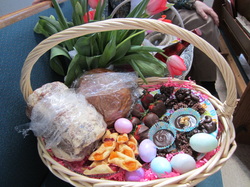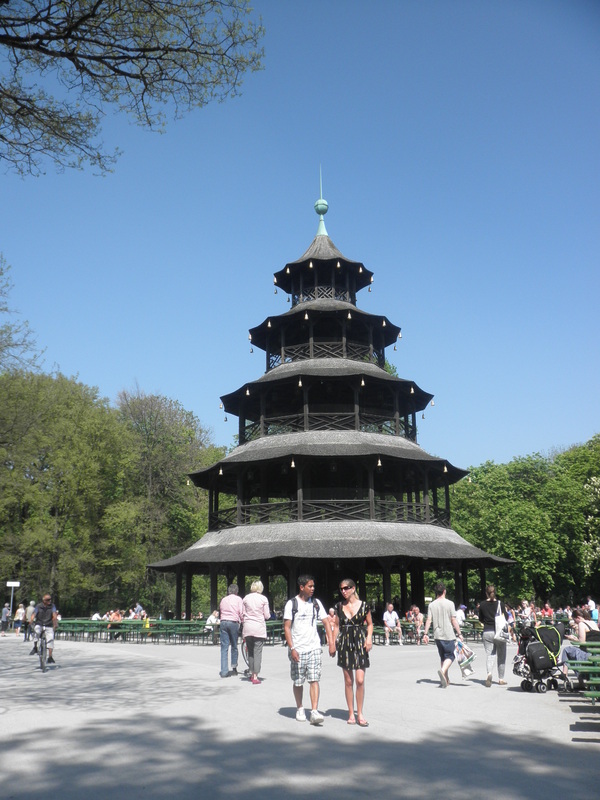
Notice how the Madonna and Child are completely encased minus the globe in her hand - its for those leaving a special prayer or wish!
| As the patron saint of England, St. George is also the patron saint for Catalonia, the north-eastern region of Spain. Montserrat, the “jagged mountain” that is fabled to be the great dragon that St. George slew, is located near the city of Barcelona and is home to one to one of the most venerated holy places in the country, Santa Maria de Montserrat, a Benedictine Abbey and basilica. Inside the sanctuary of the basilica, raised above and behind the alter, you’ll ascend to find the Virgin of Montserrat, patroness of Catalonia and one of the Black Madonnas of Europe. To make a wish at the foot of the statue while touching the globe in her hand is considered extra holy (wait time: about 35 minutes in line).
| The Escolania, Montserrat Boy’s Choir, is one of the oldest in Europe and they sing everyday at 1pm in the basilica. Between the ages of 9 and 14, their voices are that of angels with their sound resonating over the hushed 2,000+ audience breathlessly listening. Visit Video and Music Clips for videos of the Escolania and the Gallery for pictures of Montserrat, the Abbey and Basilica. You can easily locate the videos and pictures under the "Spain" category. As for traditions on St. George’s Day in Catalonia, this holiday is celebrated like our St. Valentine’s Day as a day for lovers. In tradition, a male will present roses to his lover and the lady then reciprocates with a book. Recently, the exchange of gifts is done by either partner. Why a book? Authors Cervantes and William Shakespeare are rumored to have both died on the 23rd of April (some say Cervantes died two weeks earlier than Shakespeare but the specificity of calendars between England and Spain is unknown).
Just as Ireland has St. Patrick, England has St. George. As the patron saint of England, St. George has religious roots that have grown into somewhat mythical stories. Mainly known for the romanticized account of slaying the dragon, St. George is also considered one of the most renowned military saints as English Crusaders wore his sign (a red cross on a white background) into battle. In lieu of heavy drinking and parading about in red and white, this holiday is much quieter as celebrants wear a red rose in the hole of their lapel, though its popularity is on the rise as Englishmen are trying to get this holiday into a nationally recognized holiday. St. George is also the patron saint of scouting. Woo scouting! Click here to learn more about St. George and this holiday!
When I set my arrangements for Istanbul, I was excited to experience authentic Turkish food for the first time. Having read about the diversity of their culinary work, I was surprised to hear that Turkish cuisine is full of herbs like sage and rosemary layered on meats, grains and vegetables.
Most people assume that Turkish food is all kebabs and baklava. The kebab doesn’t even originate from Istanbul! It actually comes from an area of Turkey that is further East into the country. Nevertheless, the kebab is readily available (especially near tourist attractions), but the bread is dry and flavorless and the meat is nothing special making the higher price unjustifiable. Long story short, skip the kebab sandwiches. If you want kebabs, look in residential neighborhoods for meat specialty restaurants. However, one thing that is worth getting at the kebab sandwich stands is the pomegranate juice. There is something satisfying about watching fresh pomegranates get squeezed by hand, on the spot, just for you. Think of the antioxidants!
And although the kebabs do not live up to the hype in Istanbul, the baklava does. On my last day there, I was sick to my stomach from eating a fist-sized slice of the sticky dessert. The napkin on which it was presented to me was stained with butter grease.  While in Istanbul, the real cuisine is fish. The fish and tomato sandwiches, fried mussels with rice and squid are all fantastic. Head to the Eminönü district for everything fishy.
Tea is another culinary delight. Turkish people drink the most tea per day, an average of 20 cups a day, according to a 2003 study. Most cafés will give you complimentary glasses of tea after you order the first one. In addition to black tea, many locals drink apple tea as well, which tastes like warm apple cider.
 Check out an article by Harold McNeil and Michelle Kearns of the Buffalo News for a look on the day's festivities! Also, here is another article by Michelle Kearns which gives a bit more of the history of Dynus Day celebrations in Buffalo.
Honestly, how do they come up with these ideas?? Can you imagine what Back to the Future, Part II would have been like had they lived in China? Always thinking towards the future, Chinese architects and contractors have begun construction on a hotel that will go 100 meters into the ground. Read on in the Huffington Post for more info.
Anyone near Holland? Get yourself over to Venlo to see 1.8 million blooming tulip bulbs!! Runs until Oct. 7, 2012 Check out the Huffington Post's article for more info.
Every Holy Saturday my mom and I spend our morning preparing our Easter baskets for the Easter basket blessing known as swieconka (shvee-TSON-ka). A tradition that is exclusively Polish, this blessing celebrates the Resurrection of Christ and the ending of Lent. In lieu of the Easter bunny, the Lamb, the symbol of Christ, takes the spotlight usually in butter form known in Polish as “baranek” (ba-RON-ihk, lightly roll the “r”). And of course we have to get our ingredients from the Broadway Market (see neighboring article). 
Into our main basket goes: a baranek, fresh and smoked kielbasa, ham, eggs, horseradish, mustard, ketchup, bread, salt and pepper, and wine (this year there is an added "Elephant's Ear" and Pączki or a Polish donut).
| 
Into the goodies basket (which is typically loaded) goes: chocolate covered fruits (strawberries, pineapple) and nuts (peanuts, cashews, and walnuts), our chocolate Easter bunnies from Kelly’s Country Store and sponge candy. Need I say that our family likes chocolate?
| It’s a nice, simple tradition that my mom and I have come to cherish through the years. The blessing is only 15 minutes long at your nearest Catholic church, though you might need to touch base with the priest as not all churches offer this blessing.  (Left) Nancy Korkuc and Maribeth Mroziak present their newly blessed baskets. |  Dylan and Ella Zaremski share their Easter traditions with visiting cousins Madison and Abigail Depp of Ohio. |
Dyngus Day 2012: so much fun. With all of the venues playing host for this annual Polish celebration throughout the “Historic Polonia” section of East Buffalo (as well as its surrounding suburbs of Cheektawaga and Depew), it seemed practically impossible to not have a good time. I spent most of my evening at the Central Terminal but hopped over to Corpus Christi Church (Clark St, Buffalo) for a few dances and then on to the Hearthstone Manor (Dick Rd, Cheektawaga) where I polka’ed myself into a frenzy. (Check out the official site here for further Dyngus information) Yes, it was cold. Yes, I was whipped by pussy willows and sprayed with water (I thought my hair would freeze as I was waiting in line for the bathrooms outside the Terminal). Yes, I drank Tyskie (not really a beer I recommend as the Polish are known – and should only be known, alcoholically – for their vodkas). But boy oh boy! There were thousands of people proudly wearing the red and white colors of Poland everywhere you looked; it was like a sea of Polish pride – and I loved it. Those Idiots provided the soundtrack for the evening with their music filling every crevice of the Terminal. Mouth-watering food was available for purchase with a menu that included cheese pierogies (pia-RUG-gee, roll the “r”), kielbasa and sauerkraut, fried bologna and onions, Gołąbki (guh-WUMB-ki) and potatoes. The line for food took about 20 minutes to get through but the wait was worth every lip-smacking bite. My only negative from my time at the Terminal was the lack of dancing. Maybe there was dancing going on closer to the stage, but I didn’t see any when I passed earlier. Onto the next venue!  Cheese pierogies and Polish sausage with sauerkraut |  People come in from all over the country to visit family and friends for Easter. Here is Nicole LaMonte, visiting from Las Vegas, on her first Dyngus Day! |  Central Terminal, Buffalo, NY | Walking through the East Side of Buffalo at night, even on a “holiday” night is not the best idea but I was with another girl friend and four others guy friends so I thought myself safe enough. Walking into Corpus Christi’s Social Center, immediately we heard music. Heading right towards the source, the song changed and went into that famous wedding polka song we all know, The Chicken Dance. At that point of the night, the crowds were starting to die down so dance floor was wide open. My friends and I joined an older gentleman (maybe about late 60’s) and started the routine dance steps. As the song increased in speed, so did our motions and it soon became glaringly apparent that this gentlemen was a seasoned veteran – much better than we were! In the chorus of the song, he was the one leading us round and round in the circle to a speed that felt like side-step sprinting! The crowd at Corpus Christi was much older than those at the Terminal. Not necessarily a problem, but we were sticking out like a sore thumb. Onto the next venue!
Ending our evening at the Hearthstone Manor was ideal. Hosted by Chopin’s Singing Society, the originals organizers of Dyngus Day Buffalo (back in 1961), the banquet hall was booming with people (young and old) and music. Alternating between City Side Band and Eddie Biegaj & the Crusade, there was never a moment to break. Polka after polka kept the dance floor full of dancers spinning in excitement; I had a hard time staying off the dance floor myself. The wonderful thing about Dyngus Day and polka music is that it seems all inhibitions get thrown out the window; if you want to ask someone to dance, you really have nothing to worry about. More likely than not, your chosen partner will say yes and before you know, you’ll be laughing hysterically as you bob across the floor.
Some some people may see Dyngus Day as a silly excuse for a holiday, but the fact remains that it is part of our Polish-American heritage and we are proud of it. It was wonderful to be surrounded by people sharing their Polish traditions (or even people who just wanted to join in on the fun!), overflowing the venues and pouring out onto the street where they continued their revelry into the morning hours. It shouldn’t be surprising that each year brings in more and more party-goers connecting those who have come back to the “old neighborhood” and those who are experiencing Dyngus Day for the first time. Next year, the holiday falls on April Fool’s Day and there may be the appearance of the first time appointed Prince of the Pussy Willows, Anderson Cooper (of CNN); I can’t wait to see what the party will offer! Na zdrowie and sto lat my friends!
The Englischer Garten (“English Garden”): my vote for Best Place to Just Be. With all the amenities this park offers its guests, I think the best thing to do is just lie about in the grass and soak in some vitamin D! Known for being one of the biggest urban parks in the world, the English Garden stretches from the heart of Bavaria’s München (near Odeonsplatz) into the northeastern city limits. The park is full of wide open spaces perfect for sunbathing (in swim-gear or in the nude!), picnics, pick-up sports games and outdoor music sessions. Especially on hot days, ice-cream carts are pushed around with a stream of children and adults hastily on their heels waiting (almost impatiently) for a refreshing cool-off. The shady tree-lined paths offer an escape from the sun, twisting and turning in over 16 miles of pathways across the park. Several of these pathways will lead you to the beer garden at the Chinesischer Turm (Chinese Tower).  Sunbathing in the nude! |  the Chinese Tower |  the Monopteros | Now the deal with the beer gardens is that you can bring in whatever you’d like to eat, you just need to drink the beverages offered by the adjoining food stands/establishments, i.e. their beer (…when in Rome, do as the Romans!). Typically situated under the canopy of chestnut trees, guests can conveniently munch on some good ol’ fashioned German grub while hauling back liters upon liters of beer. In my experience in the beer garden under the Chinese Tower, I ordered a bratwurst (BRAHT-vuhst) and a knödl (k’NOO’dl) with gravy in the cafeteria-styled food pick-up line. Honestly, it didn’t look very exciting, but the rich and embodying flavors of the bratwurst were balanced by the simplicity of the hearty knödl making the pairing just right. Pretzels (that could easily wrap around my body twice if unknotted) piled high in baskets at the checkout counter. Cheesecake and fruit crumbles were the options as dessert. Because I was never much of a beer drinker, I opted for the ½ liter of half lemonade-half beer option (Radler) but there was the liter option that would probably set you back 8euro. To my surprise, I was able to finish my ½ liter. To some of you, that may not seem like a big deal, but it was only just last October that I was able to successfully complete a pint of beer (clearly, I’m moving up in the world).  Doesn't look special, but it was oh-so good! |  My finished half pint on the right. Woo! |  Freshly baked pretzels, nom nom nom | Outside of sunbathing in the nude and drinking in public, the English Garden also gives its guests three other beer gardens (Seehaus, Hirschau and Aumeister), the Monopteros (a Greek looking temple overlooking the southern part of the English Garden), a Japanese teahouse (given to Munich as a gift to celebrate the 1972 Olympics) as well as creeks in which to swim and even surf!
As for beer gardens, there are many others to explore throughout the city. Here are some you can’t miss: the Augustiner Keller (oldest beer garden in Munich), the Viktualienmarkt, home to the iconic maypole and a daily market of foods, plants and gifts and the Hofbräuhaus (I finished my first liter here! So, so proud of myself.)  Biergarten at the Hofbräuhaus |  Maypole in Viktualienmarkt |  Prost! I finished a liter! |
|




















 RSS Feed
RSS Feed